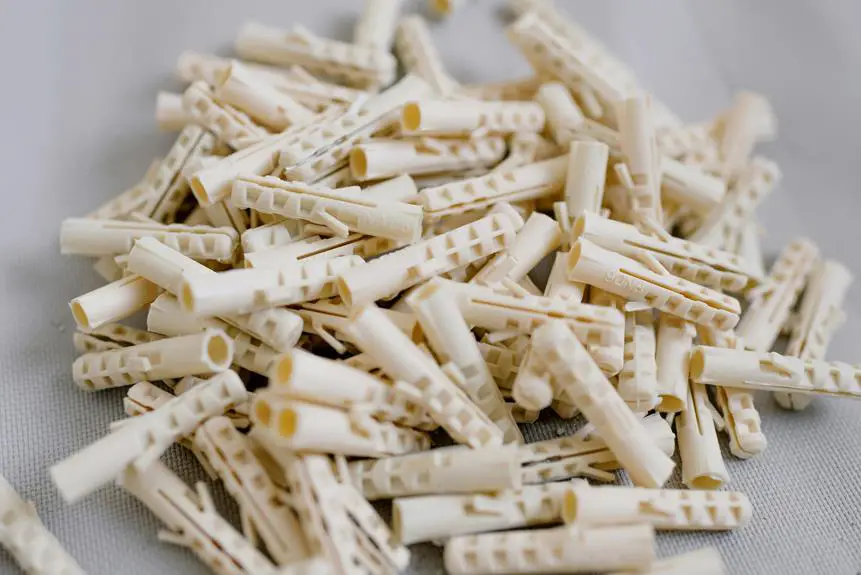If you've noticed scratches on your microsuede fabric, it can be frustrating, but don't worry—there are effective ways to address the issue. Start by assessing the damage and gathering the right supplies, like a soft-bristle brush and a microfiber cloth. Once you're equipped, cleaning the area properly is crucial to ensure a successful repair. From there, you'll discover techniques that can significantly minimize the appearance of those scratches. But what happens when the scratches are deeper than expected? Let's explore the options that can help restore your fabric to its former glory.
Table of Contents
Key Takeaways
- Assess the scratches' depth and type to choose appropriate repair techniques for microsuede.
- Clean the scratched area with a damp cloth and mild soap to remove dirt.
- Use a soft-bristle brush to gently lift fibers and restore the fabric's texture.
- Employ steam treatment to rejuvenate microsuede and lift damaged fibers back into place.
Understanding Microsuede Fabric
Microsuede fabric, a popular choice for furniture and clothing, mimics the softness of genuine suede while being more durable and easier to clean.
It's made from polyester fibers that are woven tightly, creating a luxurious texture that resists wear and tear. You'll appreciate how this material holds up against daily use, making it perfect for busy households or active lifestyles.
When you choose microsuede, you're opting for a fabric that's stain-resistant and can be cleaned with just a damp cloth or mild detergent. Unlike natural suede, which can absorb liquids and stain easily, microsuede repels spills, making it a practical choice for furniture.
Its versatility also allows it to come in various colors and patterns, fitting seamlessly into your home décor.
However, while microsuede is resilient, it's not completely immune to scratches or damage. Understanding its properties helps you take better care of your items.
With the right maintenance, you can keep your microsuede looking fresh and appealing for years to come. So, get ready to enjoy its benefits while being aware of how to handle minor issues that may arise.
Assessing the Damage
Before you start any repairs, take a close look at the scratches to determine their depth and extent. This step is crucial because not all scratches are created equal. Some may only affect the surface fibers, while others could penetrate deeper into the fabric. Use your fingers or a soft cloth to gently run over the scratched area; this will help you gauge the damage more accurately.
Next, assess whether the scratches are linear or if they've created any frayed edges. Linear scratches are often easier to fix than those with fraying, which may require more careful handling. If you notice any discoloration or a change in texture, take note of that, too, as it might influence your repair approach.
Gathering Necessary Supplies
Before you start repairing scratches on your microsuede fabric, you'll need to gather some essential tools.
You should also look into suitable cleaning solutions and protective measures to ensure the repair lasts.
Having everything ready will make the process smoother and more effective.
Essential Tools Required
Gathering the right tools is crucial for effectively repairing scratches on microsuede fabric. With the right supplies at your fingertips, you'll be better equipped to tackle those pesky scratches.
Here's a quick list of essential items you'll need:
- Soft-bristle brush – This helps gently lift the fibers and restore the fabric's texture.
- Microfiber cloth – Perfect for cleaning the area without causing further damage.
- Fabric protector spray – A good protector will help prevent future scratches and keep your microsuede looking fresh.
- Spoon or dull knife – Use this to carefully lift fibers and smooth out the damaged area without tearing the fabric.
Having these tools ready will streamline your repair process. You'll find that using the soft-bristle brush helps blend the scratched area back into the surrounding fabric.
The microfiber cloth will ensure the surface is clean before you start.
Don't forget to apply the fabric protector once you've completed your repairs; it's a smart move to keep your microsuede looking its best.
With these essentials in hand, you're well on your way to restoring your microsuede's beauty.
Cleaning Solutions Overview
To effectively repair scratches on microsuede, you'll need to choose the right cleaning solutions that won't damage the fabric while helping to restore its appearance. Start by gathering supplies that are specifically designed for microsuede or similar materials. This will ensure you don't inadvertently cause further damage.
Here's a quick overview of cleaning solutions you might consider:
| Cleaning Solution | Purpose | Usage Tips |
|---|---|---|
| Mild Soap | General cleaning | Mix with water; test on a small area first. |
| Rubbing Alcohol | Spot treatment | Apply with a soft cloth; avoid soaking the fabric. |
| Fabric Protector Spray | Prevents future stains | Use after cleaning; follow product instructions. |
Make sure you have a soft cloth or sponge handy for application. If you're unsure about a product, always test it in an inconspicuous spot before applying it to the entire area. This way, you can confidently proceed with the repairs, knowing you're using the right solutions for your microsuede fabric.
Protective Measures Needed
It's essential to regularly stock up on the right supplies to effectively protect and maintain your microsuede fabric. By having the necessary items on hand, you'll be better equipped to prevent and address scratches before they become a bigger issue.
Here are four key supplies you should gather:
- Microsuede Cleaner: Choose a cleaner specifically designed for microsuede to avoid damaging the fibers.
- Soft Brush: A soft-bristled brush helps lift dirt and restore the fabric's texture without causing further damage.
- Protective Spray: Look for a fabric protector that repels stains and moisture, extending the life of your microsuede.
- Lint Roller: This handy tool can quickly pick up pet hair and debris, keeping your fabric looking pristine.
Having these supplies ready will make it easier for you to tackle any issues that arise.
Cleaning the Affected Area
Start by gently brushing the scratched area with a soft, dry cloth to remove any loose dirt or debris. This step helps prevent further damage during the cleaning process.
Once you've cleared away the surface dirt, dampen another clean cloth with lukewarm water. Make sure it's not soaking wet; you want it just slightly moist.
Next, gently dab the scratched area with the damp cloth, working from the outside of the scratch towards the center. Avoid rubbing, as this can worsen the scratch or push dirt further into the fabric.
After dabbing, take a separate dry cloth and blot the area to absorb any excess moisture.
If the scratch has dirt embedded in it, you might want to use a mild soap or a specialized microsuede cleaner. Apply a small amount to the damp cloth and repeat the dabbing process.
Rinse the cloth and dab the area again to remove any soap residue. Finally, let the fabric air dry completely before moving on to the repair techniques. Keeping the area clean is crucial for effective scratch repair.
Repair Techniques for Scratches
When it comes to repairing scratches on microsuede, there are effective techniques you can use.
The brushing technique helps restore the fabric's texture, while steam treatment can eliminate deeper scratches.
Let's explore these methods to bring your microsuede back to life.
Brushing Technique for Restoration
Regularly brushing microsuede fabric can effectively restore its appearance and minimize the visibility of scratches. By using the right technique and tools, you can bring back its soft texture and vibrant look. Here's how to do it:
- Choose the right brush: Use a soft-bristle brush specifically designed for microsuede. Avoid stiff brushes that can damage the fabric.
- Brush gently: Start brushing in one direction, using light, even strokes. This helps lift the nap and can reduce the appearance of scratches.
- Work in sections: Focus on one area at a time. This allows you to pay attention to scratches and ensures a consistent finish.
- Check your progress: After brushing a section, step back to observe. Make adjustments as needed, and ensure you're restoring the fabric's natural appearance.
Steam Treatment Method
Using steam to treat scratches on microsuede can effectively lift the fibers and restore the fabric's original look. This method is simple and can be done at home with the right tools. First, gather your steam source, like a handheld steamer or an iron with a steam function.
Here's a quick guide on how to execute the steam treatment:
| Step | Action | Tips |
|---|---|---|
| 1. Prepare | Fill your steamer/iron with water | Use distilled water to prevent mineral buildup |
| 2. Test | Test steam on a hidden area | Ensure the temperature is safe for microsuede |
| 3. Apply | Hold the steamer/iron a few inches away | Move in circular motions to avoid water pooling |
| 4. Finish | Let the fabric dry naturally | Avoid direct sunlight to prevent fading |
After steaming, gently brush the area with a soft brush to help the fibers stand upright. This method not only repairs scratches but also rejuvenates the overall appearance of your microsuede. With a bit of patience, you'll have your fabric looking fresh and new again!
Preventive Care and Maintenance
To keep your microsuede fabric looking its best, it's essential to implement a few simple preventive care practices. These steps not only protect the fabric but also prolong its lifespan, ensuring it remains stylish and appealing.
Here's what you should do:
- Regular Vacuuming: Use a soft brush attachment to remove dust and debris. This prevents dirt from embedding itself into the fibers and causing damage.
- Avoid Direct Sunlight: Position your microsuede furniture away from direct sunlight. Prolonged exposure can fade the color and weaken the fabric.
- Use a Fabric Protector: Apply a microsuede-specific fabric protector after cleaning. This creates a barrier against stains and spills, making it easier to clean up any messes.
- Prompt Stain Treatment: Address spills and stains immediately. Blot them with a clean cloth instead of rubbing, which can spread the stain and damage the fibers.
Frequently Asked Questions
Can I Use Regular Fabric Cleaners on Microsuede?
You shouldn't use regular fabric cleaners on microsuede. They can damage the delicate fibers and alter its appearance. Instead, opt for cleaners specifically designed for microsuede to maintain its texture and color.
How Do I Test a Repair Method on Microsuede?
To test a repair method on microsuede, pick an inconspicuous area. Apply the method lightly, then observe for any discoloration or damage. Wait a few hours before assessing the results to ensure accuracy.
Is It Safe to Iron Microsuede Fabric?
Ironing microsuede isn't recommended, as heat can damage the fabric's texture. Instead, try steaming or using a wrinkle release spray. Always test any method on a hidden area first to ensure safety and effectiveness.
What Should I Do if the Scratch Is Deep?
If the scratch is deep, you should consider using a fabric repair kit specifically designed for microsuede. Apply it according to the instructions, and fluff the area with a soft brush to restore its appearance.
Can I Machine Wash Microsuede Items?
You can't machine wash microsuede items, as it may damage the fabric. Instead, spot clean with a damp cloth or a mild detergent to maintain its appearance and texture without risking further harm.
- How Does Ring Spun Cotton Affect Garment Fit and Shape Retention? - August 13, 2024
- What Are the Challenges in Producing Ring Spun Cotton? - August 13, 2024
- Is Ring Spun Cotton Suitable for Plus-Size Clothing? - August 13, 2024







